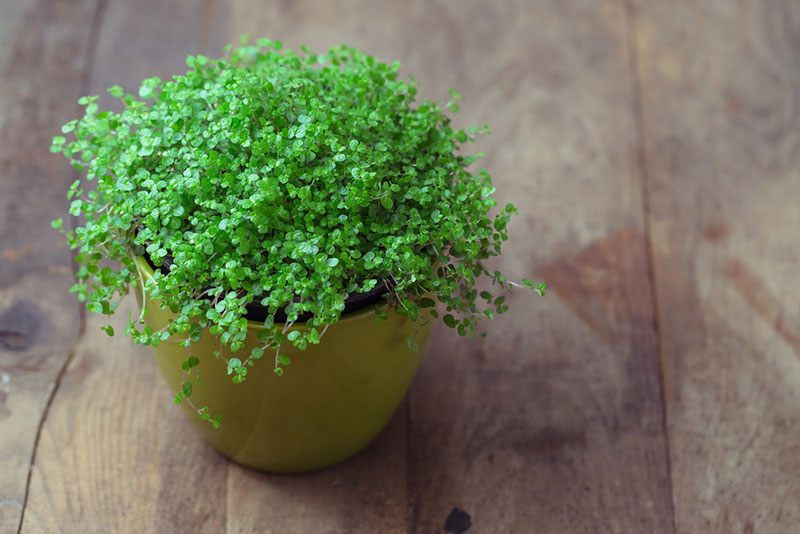
Named because of its tiny leaves, Baby’s Tears (Soleirolia soleirolii) makes a beautiful hanging or terrarium plant in the home and a lush, emerald green outdoor carpet when planted in the garden. Some of its other names are less poignant. Mind-your-own-business is one, and the Corsican curse is another.
Soleirolia soleirolii is an evergreen that produces tiny, pedal-less, cream-colored flowers in late spring. It grows only 3 to 6 inches tall and has a spread of 3 to 6 feet. Baby’s tears evolved in the heat of the western Mediterranean and thrives in hardiness zones 9 to 11.
Watering
Soleirolia soleirolii needs medium watering but likes humidity and doesn’t tolerate long dry spells. As a houseplant, it needs to be misted every other day or so. The soil should never be soggy.
Light and Temperature Requirements
Despite the fact that baby’s tears is pretty much a tropical plant, it does not like direct sunlight, which scorches it. It also doesn’t do well when temperatures grow too high, so it’s best planted in the shade or in an area that gets bright but not direct sunlight. Ideal air temperatures shouldn’t get much hotter than 65 degrees Fahrenheit or much lower than 50 degrees F.
As baby’s tears don’t like great heat, it does not tolerate frost. However, if a light frost hits it, it’s apt to grow back in the spring. A woodland garden is probably the best place for it if its going to be planted outdoors, but the gardener will have so much more control over the growing conditions if the plant is grown inside.
Soil
Baby’s tears do best in soil that is loamy, rich, moist and well-drained. It needs regular potting soil amended with peat moss. The trick is to add just the right amount of peat moss, for too much will hold on to water and make the soil too wet. A bit of perlite added to the soil will help drainage. One rule of thumb is to water the plant when the soil an inch or so below the surface is beginning to dry out. Baby’s tears is also great for a terrarium, as the environment within the glass keeps the atmosphere constantly humid.
Fertilizer
The houseplant should be fertilized every other week during its growing season. If it’s outdoors, it may not need feeding at all. The one complaint a gardener may have about Soleirolia soleirolii is that it’s invasive. Some don’t mind the beautiful green ground cover growing everywhere, but others mind it showing up in areas where they don’t want it. Though it’s easy to pull the plant up, it’s actually hard to get rid of it permanently as even tiny bits of the stem will regrow.
Propagating
Since baby’s tears love to naturalize outdoors anyway, propagating it is easy. Carefully pull the root ball in half, then plant one half in one pot and the other in another pot. Then, water well.
Other Tips
Some gardeners prune their Soleirolia soleirolii when it starts getting unruly. Gardeners shouldn’t be afraid to prune hard and frequently. It won’t hurt the plant.




